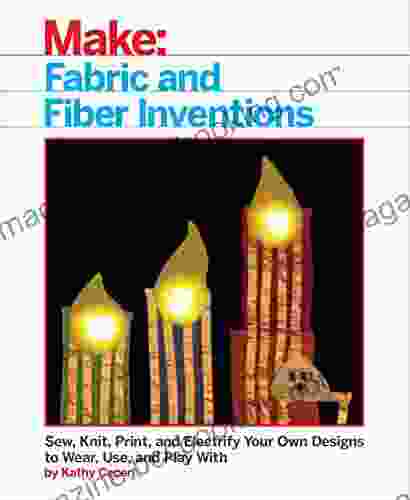Fabric and Fiber Inventions: Revolutionizing the Textile Industry

4.4 out of 5
| Language | : | English |
| File size | : | 69705 KB |
| Text-to-Speech | : | Enabled |
| Screen Reader | : | Supported |
| Enhanced typesetting | : | Enabled |
| Word Wise | : | Enabled |
| Print length | : | 219 pages |
Textiles, the woven fabrics that clothe and adorn us, have a rich and fascinating history. From the earliest days of human civilization, people have been experimenting with different fibers and fabrics to create clothing, shelter, and art. Over the centuries, countless fabric and fiber inventions have been made, each one contributing to the development of the textile industry and shaping the way we live today.
In this article, we will explore some of the most groundbreaking fabric and fiber inventions throughout history. We will learn about their origins, their impact on the textile industry, and their continued relevance in modern-day fashion and technology.
Ancient Fabric and Fiber Inventions
Some of the earliest fabric and fiber inventions date back to ancient times. In fact, the first known textiles were made from natural fibers, such as cotton, wool, and linen. These fibers were spun into yarn and then woven into fabric.
One of the most important early fabric inventions was the loom. The loom is a device that allows weavers to create fabric by interlacing threads of yarn. The first looms were very simple, but over time they became more sophisticated and efficient. The development of the loom made it possible to produce large quantities of fabric, which in turn led to the growth of the textile industry.
Another important early fabric invention was the spinning wheel. The spinning wheel is a device that allows spinners to create yarn from raw fibers. The first spinning wheels were invented in India around 500 AD. The spinning wheel made it possible to produce yarn more quickly and efficiently, which in turn led to the increased production of fabric.
Medieval Fabric and Fiber Inventions
During the Middle Ages, several important fabric and fiber inventions were made. One of the most important was the invention of the knitting machine. The knitting machine is a device that allows knitters to create fabric by looping yarn together. The first knitting machines were invented in Europe around the 16th century. The knitting machine made it possible to produce knitted fabric more quickly and efficiently, which in turn led to the increased popularity of knitted clothing.
Another important fabric invention during the Middle Ages was the development of new dyeing techniques. Dyers began to use natural dyes, such as indigo and madder, to create a wider range of colors. The development of new dyeing techniques made it possible to create more colorful and intricate fabrics.
Renaissance Fabric and Fiber Inventions
During the Renaissance, several important fabric and fiber inventions were made. One of the most important was the invention of the power loom. The power loom is a loom that is powered by a machine, rather than by hand. The power loom made it possible to produce fabric more quickly and efficiently, which in turn led to the increased production of textiles.
Another important fabric invention during the Renaissance was the development of new printing techniques. Printers began to use woodcuts and metal engravings to create printed fabrics. The development of new printing techniques made it possible to create more complex and colorful fabrics.
Industrial Revolution Fabric and Fiber Inventions
The Industrial Revolution brought about a number of important fabric and fiber inventions. One of the most important was the invention of the cotton gin. The cotton gin is a device that separates cotton fibers from cotton seeds. The invention of the cotton gin made it possible to produce cotton more quickly and efficiently, which in turn led to the increased production of cotton textiles.
Another important fabric invention during the Industrial Revolution was the development of new synthetic fibers. Synthetic fibers are fibers that are made from chemicals, rather than from natural materials. The first synthetic fibers were invented in the late 19th century. Synthetic fibers are often stronger and more durable than natural fibers, and they can be used to create a wider range of fabrics.
Modern Fabric and Fiber Inventions
In the 20th and 21st centuries, a number of important fabric and fiber inventions have been made. One of the most important is the invention of spandex. Spandex is a synthetic fiber that is highly elastic. Spandex is used in a wide range of clothing items, such as swimwear, sportswear, and lingerie.
Another important fabric invention in recent years is the development of smart fabrics. Smart fabrics are fabrics that are embedded with electronics. Smart fabrics can be used to create interactive and responsive clothing. For example, smart fabrics can be used to create clothing that can track your heart rate, monitor your sleep, or even play music.
The Future of Fabric and Fiber Inventions
The future of fabric and fiber inventions is bright. Researchers are constantly developing new and innovative fabrics and fibers. These new materials have the potential to revolutionize the textile industry and the way we live.
One area of research is the development of sustainable fabrics. Sustainable fabrics are fabrics that are made from environmentally friendly materials and that are produced in a sustainable way. Sustainable fabrics can help to reduce the environmental impact of the textile industry.
Another area of research is the development of new functional fabrics. Functional fabrics are fabrics that have special properties, such as being waterproof, flame-resistant, or antimicrobial. Functional fabrics can be used to create clothing and other products that are more durable, comfortable, and safe.
The future of fabric and fiber inventions is full of possibilities. New materials and new technologies are constantly being developed, and these innovations have the potential to revolutionize the textile industry and the way we live.
Fabric and fiber inventions have played a major role in the development of human civilization. From the earliest days of human history, people have been experimenting with different fibers and fabrics to create clothing, shelter, and art. Over the centuries, countless fabric and fiber inventions have been made, each one contributing to the development of the textile industry and shaping the way we live today.
The future of fabric and fiber inventions is bright. Researchers are constantly developing new and innovative fabrics and fibers. These new materials have the potential to revolutionize the textile industry and the way we live.
4.4 out of 5
| Language | : | English |
| File size | : | 69705 KB |
| Text-to-Speech | : | Enabled |
| Screen Reader | : | Supported |
| Enhanced typesetting | : | Enabled |
| Word Wise | : | Enabled |
| Print length | : | 219 pages |
Do you want to contribute by writing guest posts on this blog?
Please contact us and send us a resume of previous articles that you have written.
 Book
Book Novel
Novel Page
Page Chapter
Chapter Text
Text Story
Story Genre
Genre Reader
Reader Library
Library Paperback
Paperback E-book
E-book Magazine
Magazine Newspaper
Newspaper Paragraph
Paragraph Sentence
Sentence Bookmark
Bookmark Shelf
Shelf Glossary
Glossary Bibliography
Bibliography Foreword
Foreword Preface
Preface Synopsis
Synopsis Annotation
Annotation Footnote
Footnote Manuscript
Manuscript Scroll
Scroll Codex
Codex Tome
Tome Bestseller
Bestseller Classics
Classics Library card
Library card Narrative
Narrative Biography
Biography Autobiography
Autobiography Memoir
Memoir Reference
Reference Encyclopedia
Encyclopedia Kim Gordon
Kim Gordon Keep Em Busy Books
Keep Em Busy Books Kenan Trebincevic
Kenan Trebincevic Kelcey Coe
Kelcey Coe Kevin Lee Allen
Kevin Lee Allen Thomas E Johnson
Thomas E Johnson Simone Davies
Simone Davies Ken Bult
Ken Bult Kathleen Flinn
Kathleen Flinn Peter Cozzens
Peter Cozzens Michele Pw Pariza Wacek
Michele Pw Pariza Wacek Matthew T Huber
Matthew T Huber Katie Cook
Katie Cook Kristina Mcmorris
Kristina Mcmorris Melvin Baker
Melvin Baker Katie Banks
Katie Banks Khaled Fahmy
Khaled Fahmy Roland Geyer
Roland Geyer Kathy Sanders
Kathy Sanders Shawn Achor
Shawn Achor
Light bulbAdvertise smarter! Our strategic ad space ensures maximum exposure. Reserve your spot today!
 Gustavo CoxFollow ·3.8k
Gustavo CoxFollow ·3.8k Jacques BellFollow ·13.1k
Jacques BellFollow ·13.1k Neil GaimanFollow ·11.5k
Neil GaimanFollow ·11.5k John KeatsFollow ·13k
John KeatsFollow ·13k Thomas MannFollow ·4.4k
Thomas MannFollow ·4.4k Pablo NerudaFollow ·4.6k
Pablo NerudaFollow ·4.6k Ted SimmonsFollow ·5.9k
Ted SimmonsFollow ·5.9k Chandler WardFollow ·5.3k
Chandler WardFollow ·5.3k

 Joshua Reed
Joshua ReedUnveiling the Profound Essence of Taekwondo: Spirit and...
Taekwondo, an ancient...

 Clarence Brooks
Clarence BrooksUnveiling Clarity: The Common Sense Guide to Everyday...
In the labyrinthine world of legal...

 Anthony Wells
Anthony WellsBless Me, Ultima: A Literary Odyssey into the Heart of...
In the tapestry of American literature,...

 Alexandre Dumas
Alexandre DumasPioneer Life Or Thirty Years A Hunter - A Captivating...
Discover the Raw and...

 Samuel Beckett
Samuel BeckettThe Mike Fisher Story: An Inspiring Tale of Faith,...
Prepare to be...
4.4 out of 5
| Language | : | English |
| File size | : | 69705 KB |
| Text-to-Speech | : | Enabled |
| Screen Reader | : | Supported |
| Enhanced typesetting | : | Enabled |
| Word Wise | : | Enabled |
| Print length | : | 219 pages |














